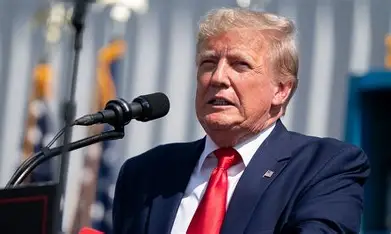President Donald Trump is viewing the ongoing government shutdown not as a crisis, but as a calculated opportunity to achieve long-standing political and administrative goals. According to multiple sources familiar with internal White House discussions, Trump and his advisers are treating the funding lapse as a way to force structural change in Washington, trim the size of the federal government, and put political pressure on his opponents in Congress.
Rather than focusing on reopening the government, Trump’s team is reportedly using the shutdown as leverage to push through controversial cuts and agency reforms that would otherwise face fierce resistance from Democrats and even some moderate Republicans. The administration believes that prolonged financial pressure will weaken opposition to its broader agenda, including plans to reorganize federal departments, reduce regulatory oversight, and shrink the federal workforce.
Trump has framed the shutdown as a necessary confrontation with what he calls a “bloated bureaucracy.” In public remarks, he has argued that the federal government has grown too large and inefficient, insisting that the crisis offers a chance to eliminate wasteful programs and hold officials accountable. Several administration officials close to Trump have described the shutdown as a “stress test” for Washington’s institutions and an opening to implement deeper reforms.
Part of the strategy has included withholding billions of dollars in federal funds earmarked for projects in Democrat-led states. This includes infrastructure, transportation, and clean energy funding. Critics say the move effectively punishes states that oppose Trump’s policies and weaponizes the shutdown for partisan gain. Analysts note that such an approach marks a dramatic departure from past presidential behavior during funding standoffs, where the primary goal was to minimize public harm rather than to exploit the situation for political advantage.
Within the administration, key figures at the Office of Management and Budget have been tasked with reviewing agency budgets to identify potential areas for permanent cuts. The team, led by Trump’s budget chief Russell Vought, has long advocated for consolidating agencies, scaling back environmental regulations, and reducing funding for social programs. Insiders suggest that Vought and others are using the shutdown to fast-track plans that could take months to pass through Congress under normal circumstances.
Conservative think tanks aligned with the administration, including those behind the “Project 2025” blueprint, have encouraged Trump to seize this moment to restructure the executive branch. Their proposals include dismantling parts of the Department of Education, merging smaller agencies, and transferring more authority directly to the presidency. Trump, who has repeatedly spoken about the need to “take power away from unelected bureaucrats,” appears to see the shutdown as a vehicle to achieve that goal.
Critics, however, warn that the approach risks serious long-term damage. Federal employee unions and watchdog organizations have condemned what they describe as an abuse of executive power. They argue that using a shutdown to force policy changes undermines democratic checks and balances and destabilizes the economy. Economists also caution that extended shutdowns harm public trust and could cost billions in lost productivity, delayed contracts, and unpaid wages for federal workers.
Democrats in Congress have accused Trump of intentionally prolonging the crisis to score political points and inflict pain on his opponents. They argue that his refusal to compromise on budget issues is creating unnecessary suffering for millions of Americans who rely on government services. Meanwhile, some moderate Republicans have expressed quiet concern that the political costs could outweigh any ideological gains if the shutdown continues much longer.
Trump’s allies maintain that the administration is acting with a clear purpose. They say the shutdown highlights inefficiencies within the federal system and demonstrates that many agencies can function with fewer resources. Supporters within the conservative movement see the current standoff as a defining moment for Trump’s second term, one that could permanently shift the balance of power in Washington toward a more centralized and executive-driven model.
As the shutdown drags on, federal employees across multiple departments remain furloughed, government contracts have been halted, and public services are increasingly strained. Yet inside the White House, there appears to be little urgency to end the standoff. Instead, Trump’s inner circle continues to frame the situation as a strategic battle for control over the size and scope of the federal government.
The political gamble carries high stakes. If the shutdown successfully forces reforms, Trump could claim a historic victory in reshaping government. But if it backfires, it could alienate key constituencies, deepen divisions in Congress, and damage public confidence in the administration’s ability to govern effectively. For now, Washington remains at a standstill, caught in a power struggle that may determine the future of federal authority in the United States.



